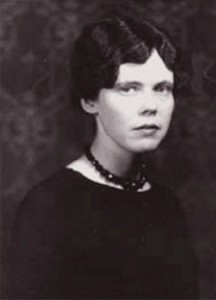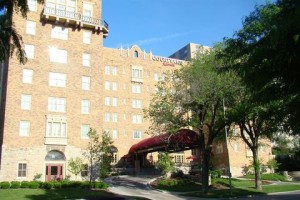While the information I will discuss in this post is probably common knowledge, I felt like it was fascinating enough that it deserved some more attention. Most of my posts have focused on interesting bits of information I have found or how my internship has changed my perception of Kansas City, but this post is simply about a site I did some research on and was truly surprised by the results…
 If you are a native of Kansas City or familiar with the local history, then the name Pendergast is probably familiar. He was the political mob boss who, under the dictation of the aptly named “Pendergast Machine,” controlled the politics and other aspects of Kansas City. One of his “associates,” Henry McElroy, served as the City Manager during the tumultuous years that Pendergast was in control. McElroy lived at 21 W 57th Street (to the right is a google map image of his house – blue) with his wife Marie and daughter, Mary. On May 27, 1933, four men drove up to the McElroy residence and kidnapped Mary, holding her hostage for 34 hours at a ransom total of $30, 000 – quite a sum for the 1930s.
If you are a native of Kansas City or familiar with the local history, then the name Pendergast is probably familiar. He was the political mob boss who, under the dictation of the aptly named “Pendergast Machine,” controlled the politics and other aspects of Kansas City. One of his “associates,” Henry McElroy, served as the City Manager during the tumultuous years that Pendergast was in control. McElroy lived at 21 W 57th Street (to the right is a google map image of his house – blue) with his wife Marie and daughter, Mary. On May 27, 1933, four men drove up to the McElroy residence and kidnapped Mary, holding her hostage for 34 hours at a ransom total of $30, 000 – quite a sum for the 1930s.
 When Mary (pictured left) was finally returned, the four kidnappers were captured and received their sentencing. What I found fascinating about this case is the fact that the ringleader of this criminals, Walter McGee was actually sentenced to death. In fact, a punishment so severe had never been given to a kidnapping offense in US history before! It is compelling that this specific punishment was passed considering Mary’s father had so much influence and was of course, infuriated by the crime. Not to mention, it is a significant judicial decision for KC and the U.S.
When Mary (pictured left) was finally returned, the four kidnappers were captured and received their sentencing. What I found fascinating about this case is the fact that the ringleader of this criminals, Walter McGee was actually sentenced to death. In fact, a punishment so severe had never been given to a kidnapping offense in US history before! It is compelling that this specific punishment was passed considering Mary’s father had so much influence and was of course, infuriated by the crime. Not to mention, it is a significant judicial decision for KC and the U.S.
I think this might be one of the most interesting stories I have stumbled upon while working on this internship, partly because it was and is so sensational and also because it demonstrates the intriguing local history in Kansas City. Since I began this internship I have found it to be incredibly enlightening and informative on all things KC. I find myself eagerly spouting off new information to my friends and family who probably only feign interest in my newest story. Overall, I think this internship has not only improved my research abilities, but it has made me more aware of the rich history that we drive and walk past everyday.
You can read the full story of Mary McElroy’s Kidnapping at the KC Public Library website: http://www.kclibrary.org/blog/week-kansas-city-history/kidnapped


